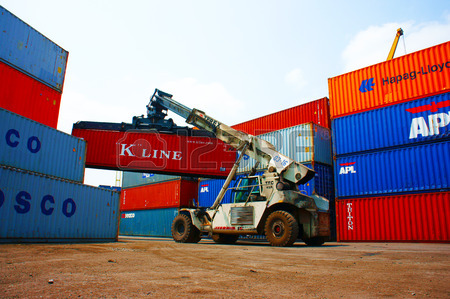Promoting Export to Optimise Market Opportunities

Promoting export to optimise market opportunities is the main theme of the Export Promotion of Vietnam Forum 2015, held recently in Hanoi. The event is one of the significant activities, contributing to a series of cooperation programmes and promoting trade and investment in Vietnam in the framework of Vietnam International Trade Fair - Vietnam Expo 2015.
Speaking at the forum, Director of Vietnam Trade Promotion Agency (VIETRADE) Bui Huy Son said that recently, the exports of Vietnam have achieved many positive results. According to the statistics from the General Department of Vietnam Customs, in 2014, the export turnover of Vietnam reached US$150.1 billion, up 13.6 percent compared with 2013. This reflects trade surplus of Vietnam within 4 recent years. It is calculated the exports of Vietnam in the first quarter of 2015 is approximately VND35.7 billions, up 6.9 percent from the same period last year. The forum took place in the context Vietnam's exports have promising results due to supporting policies for export and trade promotion is being completed, along with Vietnam's FTA negotiations with major economic partners including the EU, the Customs Union of Russia, Belarus, Kazakhstan and South Korea. This will bring more new opportunities for Vietnam's export.
In addition, at the end of 2015, the ASEAN Economic Community is officially established, which helps Vietnamese economy welcome new and comprehensive innovation. The forum will bring updates and multi-dimensional evaluation on export promotion to help Vietnamese exporters make appropriate strategies to improve their internal capacity and gradually improve their competitiveness on the international markets, contributing to rapid economic development and sustainable economic integration perspective.
According Mr Tran Thanh Hai, Deputy Director of the Import-Export Department under Ministry of Industry and Trade, despite exporting achievements, Vietnam's import and export expose many unsustainable factors. Currently, the industrial products account for two-thirds of exports but the added value of Vietnam is very low. Most raw materials, machinery, and technology are imported while Vietnam only contributes workers and local facilities, which leads to low valued added products. In addition, prices of the exporting products in agriculture, forestry and fishery depend on the world prices; Vietnamese exports also depend heavily on a certain group of products. The linkage between raw material producers, processors and exporters is still weak. The structure of the export market mainly depends on a number of markets such as the U.S., EU, Japan, and ASEAN so the fluctuation in export activities may happen if the exporters face technical barriers during the export process.
To solve these problems and take advantage of the opportunities from trade agreements, Vietnam is recommended to open for new business mindset to fit the general trend of the world. In particular, businesses need to understand and use the measures to avoid risks, awareness as well as guarantee required standards and technical barriers in the developed markets. In addition, the enterprises should change their price-competitive products to non-price competition, which is associated with standard, quality, design, and trading skills.
According to Dr Vo Tri Thanh, Vice Director of the Central Institute for Economic Management, although Vietnam promulgates economic policies for export-oriented purposes, trade promotion activities have not been focused, leading difficulties in seeking new markets. According to Thanh, the restructuring process of the economy requires the government bodies to promote administrative reform, creating conditions to enhance the competitiveness of enterprises and the competitiveness of the products. The government should assist the enterprises to develop supporting industries and access loans with reasonable interest rates to expand more investment in manufacturing products for exporting.
Mentioning to the enhancement of the export competitiveness through logistics activities, Marketing Director of the UPS Vietnam Nguyen Tran Nhu Hoa noted that currently, some enterprises are only focusing on manufacturing rather than logistics, causing many contracts not to be delivered to customers on time and affecting negatively their reputation. So, according to Ms Hoa, the enterprises not only improve the quality of the products but also invest in logistics (warehousing services) and customer services to measure satisfaction of the customers towards the products. This leads to consequences that the Vietnamese enterprises are not able to participate in the value chain of the large corporations in the world.
At the same point of view, Jeff Mclean, General Manager of UPS Vietnam shared that, Vietnam is entering a very important economic stage so it is important for the logistics industry to tackle the challenges of the changing market conditions to provide timely support for the development of the Vietnamese enterprises.
Source: http://vccinews.com/




